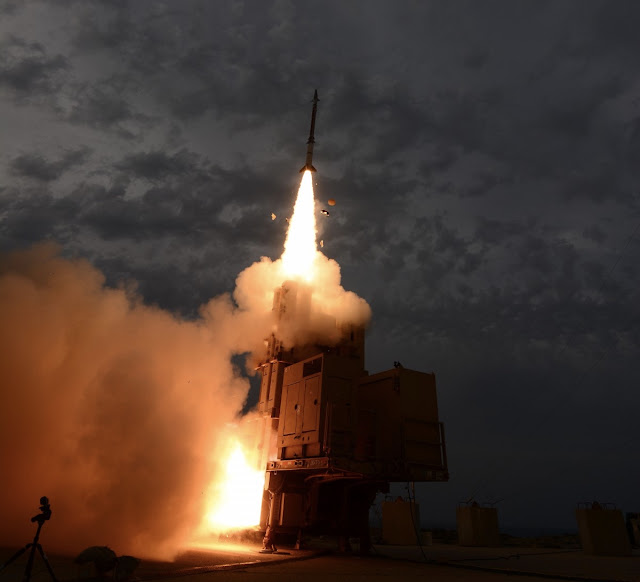IDF defends failed attempt to down Syrian missiles
The decision-making process that led to the first operational use of the David’s Sling anti-missile system last week was correct, the army said Sunday, even though technical issues led to the interceptor missiles missing their targets. “In the past few days, a complete operational inquiry was conducted by the Air Force, which found that the decision-making process of identifying the threat, considering the short amount of time, was correct,” the army said, following an investigation into Monday’s incident.
However, the technical reasons for why the missiles failed to hit their targets, which were fired from Syria, could not be published due to security concerns. “The lessons learned from this investigation will be implemented in the air defense system,” the army said. The Syrian rockets, which were fired as part of internal fighting in the country’s southwest, set off sirens throughout northern Israel on Monday morning, according to the Israel Defense Forces. The projectiles fired from Syria were identified as Russian-made OTR-21 Tochka missiles (also known as SS-21 Scarab missiles) and were in the air for a minute and a half, Hebrew media reported. The missiles can carry a 500 kilogram (half ton) warhead and have a range of 100 kilometers (60 miles).
The army calculated that the missiles were heading for Israeli territory and waited until the last moment to fire the anti-missile interceptors. After David’s Sling was launched, a recalculation showed that one of the missiles was going to land in Syrian territory, so the interceptor was redirected so as not to hit it. The Syrian missile landed one kilometer (3,000 feet) short of the border. The army did not explain what happened with the second missile.
Air raid sirens blared in the Golan Heights due to concern that shrapnel from the intercepted missiles could fall into Israel. Fighter jets were also scrambled and flown to the north during the incident, according to open-source flight tracking information. A military spokesperson would not confirm that the aircraft had been called up, saying she “couldn’t comment on air force activities.” In addition to hearing explosions, residents of northern Israel reported seeing the trails left behind by the Israeli anti-aircraft missiles.
It was the first known use of the David’s Sling system, which was declared operational last year. David’s Sling makes up the middle tier of Israel’s multi-layered anti-missile defense network. The lowest layer is the Iron Dome system, capable of intercepting short-range rockets, small unmanned aerial vehicles and mortar shells like those that have been fired at Israel from the Gaza Strip or from southern Lebanon. At the top are the Arrow 2 and Arrow 3 systems, which are intended to engage long-range ballistic missiles.
David’s Sling is aimed at filling the gap between those systems, against missiles like the Iranian Fateh 110 and its Syrian equivalent, the M600, both of which have seen extensive use in the Syrian civil war and are known to be in the Hezbollah terrorist group’s arsenal.
However, the technical reasons for why the missiles failed to hit their targets, which were fired from Syria, could not be published due to security concerns. “The lessons learned from this investigation will be implemented in the air defense system,” the army said. The Syrian rockets, which were fired as part of internal fighting in the country’s southwest, set off sirens throughout northern Israel on Monday morning, according to the Israel Defense Forces. The projectiles fired from Syria were identified as Russian-made OTR-21 Tochka missiles (also known as SS-21 Scarab missiles) and were in the air for a minute and a half, Hebrew media reported. The missiles can carry a 500 kilogram (half ton) warhead and have a range of 100 kilometers (60 miles).
The army calculated that the missiles were heading for Israeli territory and waited until the last moment to fire the anti-missile interceptors. After David’s Sling was launched, a recalculation showed that one of the missiles was going to land in Syrian territory, so the interceptor was redirected so as not to hit it. The Syrian missile landed one kilometer (3,000 feet) short of the border. The army did not explain what happened with the second missile.
Air raid sirens blared in the Golan Heights due to concern that shrapnel from the intercepted missiles could fall into Israel. Fighter jets were also scrambled and flown to the north during the incident, according to open-source flight tracking information. A military spokesperson would not confirm that the aircraft had been called up, saying she “couldn’t comment on air force activities.” In addition to hearing explosions, residents of northern Israel reported seeing the trails left behind by the Israeli anti-aircraft missiles.
It was the first known use of the David’s Sling system, which was declared operational last year. David’s Sling makes up the middle tier of Israel’s multi-layered anti-missile defense network. The lowest layer is the Iron Dome system, capable of intercepting short-range rockets, small unmanned aerial vehicles and mortar shells like those that have been fired at Israel from the Gaza Strip or from southern Lebanon. At the top are the Arrow 2 and Arrow 3 systems, which are intended to engage long-range ballistic missiles.
David’s Sling is aimed at filling the gap between those systems, against missiles like the Iranian Fateh 110 and its Syrian equivalent, the M600, both of which have seen extensive use in the Syrian civil war and are known to be in the Hezbollah terrorist group’s arsenal.





Comments
Post a Comment